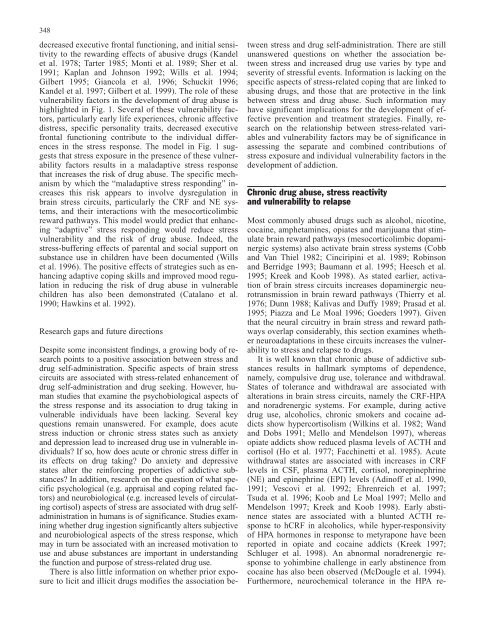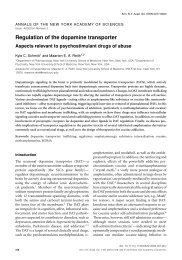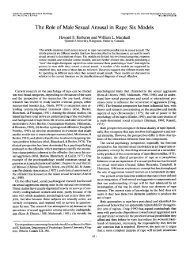How does stress increase risk of drug abuse - Addiction Research ...
How does stress increase risk of drug abuse - Addiction Research ...
How does stress increase risk of drug abuse - Addiction Research ...
You also want an ePaper? Increase the reach of your titles
YUMPU automatically turns print PDFs into web optimized ePapers that Google loves.
348<br />
decreased executive frontal functioning, and initial sensitivity<br />
to the rewarding effects <strong>of</strong> abusive <strong>drug</strong>s (Kandel<br />
et al. 1978; Tarter 1985; Monti et al. 1989; Sher et al.<br />
1991; Kaplan and Johnson 1992; Wills et al. 1994;<br />
Gilbert 1995; Giancola et al. 1996; Schuckit 1996;<br />
Kandel et al. 1997; Gilbert et al. 1999). The role <strong>of</strong> these<br />
vulnerability factors in the development <strong>of</strong> <strong>drug</strong> <strong>abuse</strong> is<br />
highlighted in Fig. 1. Several <strong>of</strong> these vulnerability factors,<br />
particularly early life experiences, chronic affective<br />
di<strong>stress</strong>, specific personality traits, decreased executive<br />
frontal functioning contribute to the individual differences<br />
in the <strong>stress</strong> response. The model in Fig. 1 suggests<br />
that <strong>stress</strong> exposure in the presence <strong>of</strong> these vulnerability<br />
factors results in a maladaptive <strong>stress</strong> response<br />
that <strong>increase</strong>s the <strong>risk</strong> <strong>of</strong> <strong>drug</strong> <strong>abuse</strong>. The specific mechanism<br />
by which the “maladaptive <strong>stress</strong> responding” <strong>increase</strong>s<br />
this <strong>risk</strong> appears to involve dysregulation in<br />
brain <strong>stress</strong> circuits, particularly the CRF and NE systems,<br />
and their interactions with the mesocorticolimbic<br />
reward pathways. This model would predict that enhancing<br />
“adaptive” <strong>stress</strong> responding would reduce <strong>stress</strong><br />
vulnerability and the <strong>risk</strong> <strong>of</strong> <strong>drug</strong> <strong>abuse</strong>. Indeed, the<br />
<strong>stress</strong>-buffering effects <strong>of</strong> parental and social support on<br />
substance use in children have been documented (Wills<br />
et al. 1996). The positive effects <strong>of</strong> strategies such as enhancing<br />
adaptive coping skills and improved mood regulation<br />
in reducing the <strong>risk</strong> <strong>of</strong> <strong>drug</strong> <strong>abuse</strong> in vulnerable<br />
children has also been demonstrated (Catalano et al.<br />
1990; Hawkins et al. 1992).<br />
<strong>Research</strong> gaps and future directions<br />
Despite some inconsistent findings, a growing body <strong>of</strong> research<br />
points to a positive association between <strong>stress</strong> and<br />
<strong>drug</strong> self-administration. Specific aspects <strong>of</strong> brain <strong>stress</strong><br />
circuits are associated with <strong>stress</strong>-related enhancement <strong>of</strong><br />
<strong>drug</strong> self-administration and <strong>drug</strong> seeking. <strong>How</strong>ever, human<br />
studies that examine the psychobiological aspects <strong>of</strong><br />
the <strong>stress</strong> response and its association to <strong>drug</strong> taking in<br />
vulnerable individuals have been lacking. Several key<br />
questions remain unanswered. For example, <strong>does</strong> acute<br />
<strong>stress</strong> induction or chronic <strong>stress</strong> states such as anxiety<br />
and depression lead to <strong>increase</strong>d <strong>drug</strong> use in vulnerable individuals?<br />
If so, how <strong>does</strong> acute or chronic <strong>stress</strong> differ in<br />
its effects on <strong>drug</strong> taking? Do anxiety and depressive<br />
states alter the reinforcing properties <strong>of</strong> addictive substances?<br />
In addition, research on the question <strong>of</strong> what specific<br />
psychological (e.g. appraisal and coping related factors)<br />
and neurobiological (e.g. <strong>increase</strong>d levels <strong>of</strong> circulating<br />
cortisol) aspects <strong>of</strong> <strong>stress</strong> are associated with <strong>drug</strong> selfadministration<br />
in humans is <strong>of</strong> significance. Studies examining<br />
whether <strong>drug</strong> ingestion significantly alters subjective<br />
and neurobiological aspects <strong>of</strong> the <strong>stress</strong> response, which<br />
may in turn be associated with an <strong>increase</strong>d motivation to<br />
use and <strong>abuse</strong> substances are important in understanding<br />
the function and purpose <strong>of</strong> <strong>stress</strong>-related <strong>drug</strong> use.<br />
There is also little information on whether prior exposure<br />
to licit and illicit <strong>drug</strong>s modifies the association be-<br />
tween <strong>stress</strong> and <strong>drug</strong> self-administration. There are still<br />
unanswered questions on whether the association between<br />
<strong>stress</strong> and <strong>increase</strong>d <strong>drug</strong> use varies by type and<br />
severity <strong>of</strong> <strong>stress</strong>ful events. Information is lacking on the<br />
specific aspects <strong>of</strong> <strong>stress</strong>-related coping that are linked to<br />
abusing <strong>drug</strong>s, and those that are protective in the link<br />
between <strong>stress</strong> and <strong>drug</strong> <strong>abuse</strong>. Such information may<br />
have significant implications for the development <strong>of</strong> effective<br />
prevention and treatment strategies. Finally, research<br />
on the relationship between <strong>stress</strong>-related variables<br />
and vulnerability factors may be <strong>of</strong> significance in<br />
assessing the separate and combined contributions <strong>of</strong><br />
<strong>stress</strong> exposure and individual vulnerability factors in the<br />
development <strong>of</strong> addiction.<br />
Chronic <strong>drug</strong> <strong>abuse</strong>, <strong>stress</strong> reactivity<br />
and vulnerability to relapse<br />
Most commonly <strong>abuse</strong>d <strong>drug</strong>s such as alcohol, nicotine,<br />
cocaine, amphetamines, opiates and marijuana that stimulate<br />
brain reward pathways (mesocorticolimbic dopaminergic<br />
systems) also activate brain <strong>stress</strong> systems (Cobb<br />
and Van Thiel 1982; Cinciripini et al. 1989; Robinson<br />
and Berridge 1993; Baumann et al. 1995; Heesch et al.<br />
1995; Kreek and Koob 1998). As stated earlier, activation<br />
<strong>of</strong> brain <strong>stress</strong> circuits <strong>increase</strong>s dopaminergic neurotransmission<br />
in brain reward pathways (Thierry et al.<br />
1976; Dunn 1988; Kalivas and Duffy 1989; Prasad et al.<br />
1995; Piazza and Le Moal 1996; Goeders 1997). Given<br />
that the neural circuitry in brain <strong>stress</strong> and reward pathways<br />
overlap considerably, this section examines whether<br />
neuroadaptations in these circuits <strong>increase</strong>s the vulnerability<br />
to <strong>stress</strong> and relapse to <strong>drug</strong>s.<br />
It is well known that chronic <strong>abuse</strong> <strong>of</strong> addictive substances<br />
results in hallmark symptoms <strong>of</strong> dependence,<br />
namely, compulsive <strong>drug</strong> use, tolerance and withdrawal.<br />
States <strong>of</strong> tolerance and withdrawal are associated with<br />
alterations in brain <strong>stress</strong> circuits, namely the CRF-HPA<br />
and noradrenergic systems. For example, during active<br />
<strong>drug</strong> use, alcoholics, chronic smokers and cocaine addicts<br />
show hypercortisolism (Wilkins et al. 1982; Wand<br />
and Dobs 1991; Mello and Mendelson 1997), whereas<br />
opiate addicts show reduced plasma levels <strong>of</strong> ACTH and<br />
cortisol (Ho et al. 1977; Facchinetti et al. 1985). Acute<br />
withdrawal states are associated with <strong>increase</strong>s in CRF<br />
levels in CSF, plasma ACTH, cortisol, norepinephrine<br />
(NE) and epinephrine (EPI) levels (Adin<strong>of</strong>f et al. 1990,<br />
1991; Vescovi et al. 1992; Ehrenreich et al. 1997;<br />
Tsuda et al. 1996; Koob and Le Moal 1997; Mello and<br />
Mendelson 1997; Kreek and Koob 1998). Early abstinence<br />
states are associated with a blunted ACTH response<br />
to hCRF in alcoholics, while hyper-responsivity<br />
<strong>of</strong> HPA hormones in response to metyrapone have been<br />
reported in opiate and cocaine addicts (Kreek 1997;<br />
Schluger et al. 1998). An abnormal noradrenergic response<br />
to yohimbine challenge in early abstinence from<br />
cocaine has also been observed (McDougle et al. 1994).<br />
Furthermore, neurochemical tolerance in the HPA re-










